Title: Gay Surrogacy 101: A Complete Guide for LGBTQ+ Intended Parents
Introduction
Surrogacy has become a life-changing path to parenthood for many LGBTQ+ individuals and couples, particularly gay men. With increasing visibility, legal progress, and medical advancements, more people are turning to surrogacy to build their families. This guide provides a comprehensive overview of the gay surrogacy process, including types of surrogacy, step-by-step procedures, financial planning, legal considerations, and emotional support—everything intended parents need to confidently begin their journey.
1. What Is Gay Surrogacy?
Gay surrogacy refers to the process by which gay men, whether single or in a couple, become parents through the help of a surrogate. While commonly referred to as “gay surrogacy,” this process is also used by other LGBTQ+ individuals and couples. For gay male couples, the process typically involves an egg donor and a gestational surrogate, allowing one or both partners to have a biological connection to the child.
2. Types of Surrogacy
There are two main types of surrogacy:
- Traditional Surrogacy: The surrogate uses her own egg, meaning she is the biological mother of the child. This method is now rare, especially for gay couples, due to its complex legal and emotional implications. Establishing parental rights can be challenging in these cases.
- Gestational Surrogacy: The most common and legally secure method. An embryo is created using the sperm of one or both intended fathers and a donor egg, then transferred to a surrogate who has no genetic relationship to the child. This separation of roles helps streamline legal rights and reduces emotional complexities.
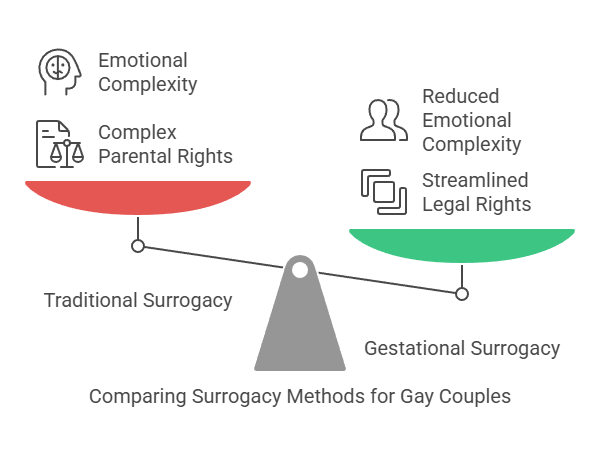
3. Step-by-Step Surrogacy Process
- Initial Research: Begin by learning about the surrogacy process and laws in your location. Not all countries or U.S. states support or permit surrogacy for same-sex couples, so understanding the legal landscape is essential.
- Choosing a Surrogacy Agency or Independent Path: Agencies provide screening, legal support, medical coordination, and surrogate matching. Some intended parents choose to go independent, which can be less expensive but involves more responsibility and risk.
- Egg Donor Selection: Donors can be anonymous or known. Intended parents typically choose based on genetics, appearance, education, health history, and personal values. Some opt for a known donor to provide a future connection for the child.
- Medical Preparation and IVF: Once a donor is selected, IVF is performed to create embryos. One or both intended fathers may contribute sperm. Genetic testing (PGT-A or PGT-M) may be used to select the healthiest embryos.
- Embryo Transfer and Pregnancy: The embryo is transferred to the surrogate’s uterus. After successful implantation, the surrogate undergoes regular medical monitoring. Many intended parents maintain frequent contact with the surrogate throughout the pregnancy to build a strong relationship.
- Birth and Postnatal Legal Steps: Depending on the country or state, pre-birth or post-birth court orders may be required to establish legal parentage. In some cases, adoption processes may still be necessary for the non-biological father.
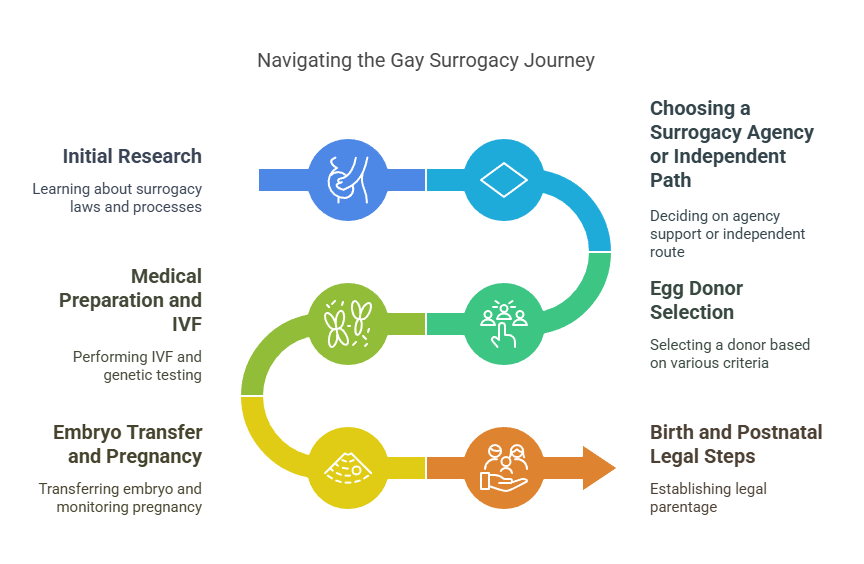
More: Finding a Surrogate Mother in Houston: A Step-by-Step Guide
4. Costs and Financial Planning
Gay surrogacy, especially in countries like the United States, is a significant financial investment. Typical costs range between $100,000–$200,000 USD, depending on location, agency fees, medical procedures, legal costs, and surrogate compensation.
More: How Much Does a Surrogate Cost in Texas? A Complete Breakdown
Main cost components include:
- Surrogate compensation (base pay, benefits, maternity coverage)
- Egg donor fees
- IVF and medical treatments
- Legal services and court fees
- Travel expenses and insurance
- Agency or coordination service fees
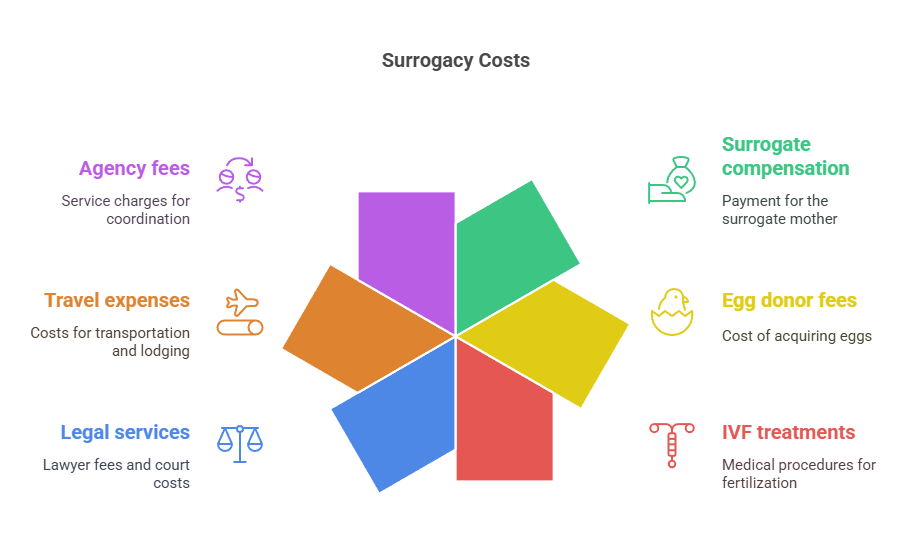
To manage these costs:
- Explore LGBTQ+ family-building grants and nonprofit programs
- Consider financing options or payment plans through fertility clinics
- Evaluate international surrogacy programs in countries like Mexico, Colombia, or Canada, which may offer lower costs with inclusive policies (but legal due diligence is essential)
5. Legal Considerations
Legal aspects of surrogacy are among the most complex, especially for gay couples. Laws vary dramatically not only by country but also by U.S. state. Some areas provide full protections, while others may prohibit or restrict surrogacy for same-sex couples.
More: Understanding Surrogacy Contracts: Protecting the Rights of All Parties
Key legal areas include:
- Parental rights: In some jurisdictions, the biological father is automatically recognized, but the non-biological father may need to adopt the child or obtain a court order.
- Birth certificates: Ensure both parents are listed, which may require legal filings.
- Citizenship: If pursuing international surrogacy, be aware of the child’s citizenship and passport eligibility.
- Contracts: Always have professionally drafted contracts outlining the responsibilities, rights, and expectations of all parties involved. A surrogacy contract helps protect both the intended parents and the surrogate.
Working with a lawyer who specializes in LGBTQ+ family law is crucial to avoid complications and ensure a smooth transition into legal parenthood.
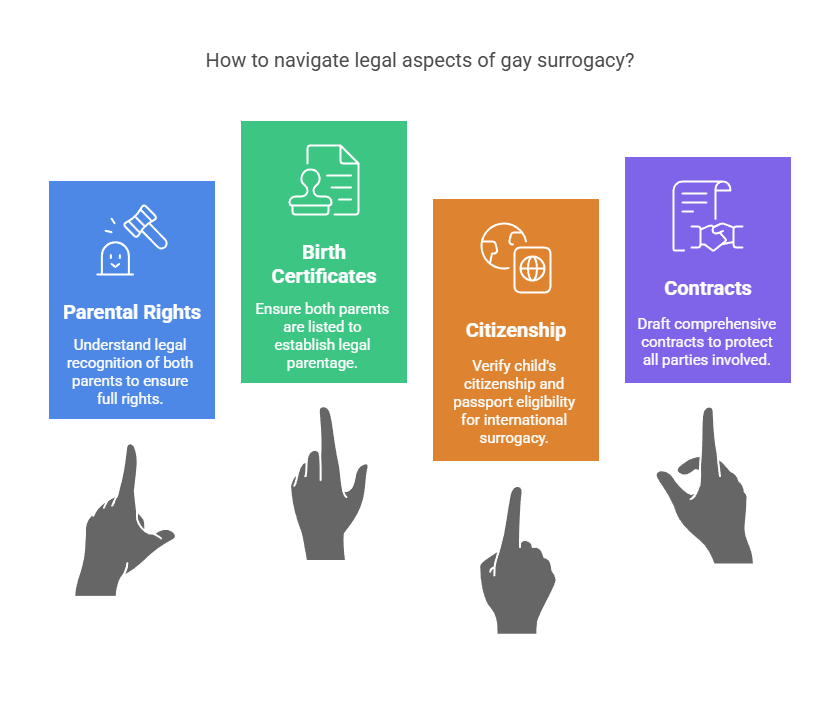
6. Emotional and Social Support
The surrogacy journey is not only a legal and medical process—it’s deeply emotional. Intended parents often experience stress, uncertainty, and anticipation. Having strong emotional support is vital.
Ways to stay supported:
- Join LGBTQ+ parenting or surrogacy support groups (online or local)
- Seek counseling or therapy to process challenges and prepare for parenthood
- Build a positive relationship with the surrogate, based on transparency and respect
- Prepare to address social perceptions or bias, and practice how you’ll share your family story confidently
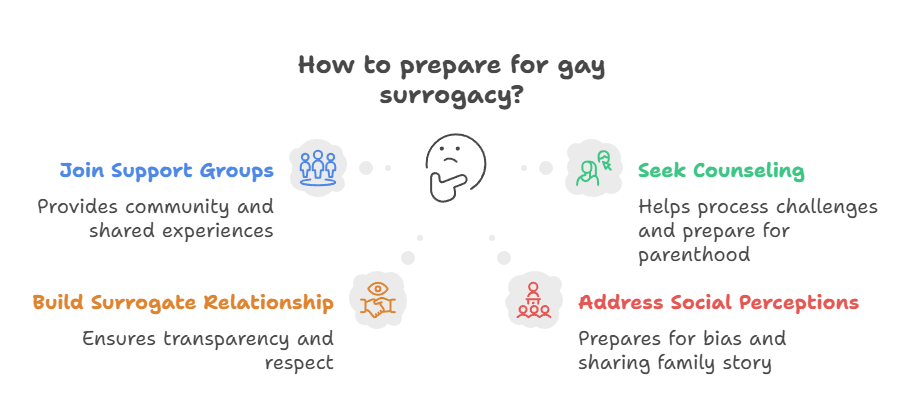
Forming a supportive community—whether through friends, other LGBTQ+ parents, or professionals—can make the experience more joyful and less overwhelming.
7. Frequently Asked Questions (FAQ)
- Can both dads be legal parents?
Yes, but it may require court orders or second-parent adoption depending on jurisdiction. - Can our child be biologically related to both dads?
Not within one child, but it’s possible for twins to be fertilized using sperm from each father. - Can we pursue surrogacy abroad?
Yes, but laws vary. Work with experienced legal professionals to avoid issues with citizenship or custody. - Can we meet or stay in contact with the egg donor?
That depends. Some arrangements allow open contact, others are anonymous based on mutual agreement.
Conclusion
Gay surrogacy opens a fulfilling, affirming path to fatherhood for LGBTQ+ individuals and couples. Although it involves planning, legal preparation, and emotional readiness, it also offers deep rewards and lasting joy. With access to the right resources, professionals, and community support, intended parents can navigate the journey with clarity and confidence—and build the family they’ve always dreamed of.




